Study of Single-Event Effects Influenced by Displacement Damage Effects under Proton Irradiation in Static Random-Access Memory
Abstract
:1. Introduction
2. Experimental Setup
3. Experimental Results
4. Results and Discussion
4.1. Monte Carlo Simulation and Modeling
4.2. TCAD and SPICE Simulation
4.3. Analysis of Synergistic Effect
- As the energy increases, for devices not subjected to proton displacement damage irradiation, the SEU cross-section of SRAM “1” consistently surpasses that of SRAM “0”. This implies that SRAM is more prone to flipping when in the “1” state.
- Conversely, for devices exposed to displacement damage irradiation, the SEU cross-section of SRAM “0” consistently exceeds that of SRAM “1”. This suggests that SRAM is more likely to flip when in the “0” state.
5. Summary
Author Contributions
Funding
Data Availability Statement
Acknowledgments
Conflicts of Interest
References
- Sun, X.; Saadat, O.I.; Chen, J.; Zhang, E.X.; Cui, S.; Palacios, T.; Fleetwood, D.M.; Ma, T.P. Total-Ionizing-Dose Radiation Effects in AlGaN/GaN HEMTs and MOS-HEMTs. IEEE Trans. Nucl. Sci. 2013, 60, 4074–4079. [Google Scholar] [CrossRef]
- Luo, Y.; Zhang, F.; Pan, X.; Guo, H.; Wang, Y. Impact of Total Ionizing Dose on Low Energy Proton Single Event Upsets in Nanometer SRAM. IEEE Trans. Nucl. Sci. 2019, 66, 1848–1853. [Google Scholar] [CrossRef]
- Luo, Y.-Y.; Zhang, F.-Q.; Pan, X.-Y.; Guo, H.-X.; Wang, Y.-M. Dependence of single event upsets sensitivity of low energy proton on test factors in 65 nm SRAM. Chin. Phys. B 2018, 27, 078501. [Google Scholar] [CrossRef]
- Schwank, J.; Shaneyfelt, M.; Baggio, J.; Dodd, P.; Felix, J.; Ferlet-Cavrois, V.; Paillet, P.; Lambert, D.; Sexton, F.; Hash, G.; et al. Effects of particle energy on proton-induced single-event latchup. IEEE Trans. Nucl. Sci. 2005, 52, 2622–2629. [Google Scholar] [CrossRef]
- Ye, B.; Liu, J.; Wang, T.-S.; Liu, T.-Q.; Luo, J.; Wang, B.; Yin, Y.-N.; Ji, Q.-G.; Hu, P.-P.; Sun, Y.-M.; et al. Impact of energy straggle on proton-induced single event upset test in a 65-nm SRAM cell. Chin. Phys. B 2017, 26, 088501. [Google Scholar] [CrossRef]
- Jiang, R.; Zhang, E.; McCurdy, M.W.; Wang, P.; Gong, H.; Yan, D.; Schrimpf, R.D.; Fleetwood, D.M. Dose-Rate Dependence of the Total-Ionizing-Dose Response of GaN-Based HEMTs. IEEE Trans. Nucl. Sci. 2019, 66, 170–176. [Google Scholar] [CrossRef]
- Brewer, R.M.; Zhang, E.X.; Gorchichko, M.; Wang, P.F.; Cox, J.; Moran, S.L.; Ball, D.R.; Sierawski, B.D.; Fleetwood, D.M.; Schrimpf, R.D.; et al. Total Ionizing Dose Responses of 22-nm FDSOI and 14-nm Bulk FinFET Charge-Trap Transistors. IEEE Trans. Nucl. Sci. 2021, 68, 677–686. [Google Scholar] [CrossRef]
- Zhao, S.E.; Bonaldo, S.; Wang, P.; Zhang, E.X.; Waldron, N.; Collaert, N.; Putcha, V.; Linten, D.; Gerardin, S.; Paccagnella, A.; et al. Total-Ionizing-Dose Effects on InGaAs FinFETs with Modified Gate-Stack. IEEE Trans. Nucl. Sci. 2020, 67, 253–259. [Google Scholar] [CrossRef]
- Li, K.; Zhang, E.X.; Gorchichko, M.; Wang, P.F.; Reaz, M.; Zhao, S.E.; Hiblot, G.; Van Huylenbroeck, S.; Jourdain, A.; Alles, M.L.; et al. Impacts of Through-Silicon Vias on Total-Ionizing-Dose Effects and Low-Frequency Noise in FinFETs. IEEE Trans. Nucl. Sci. 2021, 68, 740–747. [Google Scholar] [CrossRef]
- Xiong, Y.; Feeley, A.T.; Wang, P.F.; Li, X.; Zhang, E.X.; Massengill, L.W.; Bhuva, B.L. Supply Voltage Dependence of Ring Oscillator Frequencies for Total Ionizing Dose Exposures for 7-nm Bulk FinFET Technology. IEEE Trans. Nucl. Sci. 2021, 68, 1579–1584. [Google Scholar] [CrossRef]
- Cao, J.; Wang, P.F.; Li, X.; Guo, Z.; Zhang, E.X.; Reed, R.A.; Alles, M.L.; Schrimpf, R.D.; Fleetwood, D.M.; Arreghini, A.; et al. Total-Ionizing-Dose Effects on Polycrystalline-Si Channel Vertical-Charge-Trapping Nand Devices. IEEE Trans. Nucl. Sci. 2022, 69, 314–320. [Google Scholar] [CrossRef]
- Huang, Y.-T.; Cui, X.-H.; Yang, J.-Q.; Ying, T.; Yu, X.-Q.; Dong, L.; Li, W.-Q.; Li, X.-J. Radiation effects of 50-MeV protons on PNP bipolar junction transistors. Chin. Phys. B 2022, 31, 028502. [Google Scholar] [CrossRef]
- Liu, B.; Li, Y.; Wen, L.; Zhou, D.; Feng, J.; Ma, L.; Zhang, X.; Cai, Y.; Wang, Z.; Fu, J.; et al. A study of hot pixels induced by proton and neutron irradiations in charge coupled devices. Radiat. Eff. Defects Solids 2020, 175, 540–550. [Google Scholar] [CrossRef]
- Ding, L.; Gerardin, S.; Bagatin, M.; Bisello, D.; Mattiazzo, S.; Paccagnella, A. Investigation of total ionizing dose effect and displacement damage in 65nm CMOS transistors exposed to 3MeV protons. Nucl. Instrum. Methods Phys. Res. 2015, 796, 104–107. [Google Scholar] [CrossRef]
- Gong, H.; Liao, W.; Zhang, E.X.; Sternberg, A.L.; McCurdy, M.W.; Davidson, J.L.; Reed, R.A.; Fleetwood, D.M.; Schrimpf, R.D.; Shuvra, P.D.; et al. Proton-Induced Displacement Damage and Total-Ionizing-Dose Effects on Silicon-Based MEMS Resonators. IEEE Trans. Nucl. Sci. 2018, 65, 34–38. [Google Scholar] [CrossRef]
- Li, X.; Yang, J.; Liu, C.; Bai, G.; Luo, W.; Li, P. Synergistic effects of NPN transistors caused by combined proton irradiations with different energies ScienceDirect. Microelectron. Reliab. 2018, 82, 130–135. [Google Scholar] [CrossRef]
- Zhao, P.; Li, B.; Liu, H.; Yang, J.; Jiao, Y.; Chen, Q.; Sun, Y.; Liu, J. The Effects of Total Ionizing Dose on the SEU Cross-Section of SOI SRAMs. Electronics 2022, 11, 3188. [Google Scholar] [CrossRef]
- Bacchini, A.; Furano, G.; Rovatti, M.; Ottavi, M. Total Ionizing Dose Effects on DRAM Data Retention Time. IEEE Trans. Nucl. Sci. 2014, 61, 3690–3693. [Google Scholar] [CrossRef]
- Wang, P.F.; Zhang, E.X.; Chuang, K.H.; Liao, W.; Gong, H.; Arutt, C.N.; Ni, K.; Mccurdy, M.W.; Verbauwhede, I.; Bury, E.; et al. X-Ray and Proton Radiation Effects on 40 nm CMOS Physically Unclonable Function Devices. IEEE Trans. Nucl. Sci. 2018, 65, 1519–1524. [Google Scholar] [CrossRef]
- Wang, P.; Perini, C.J.; O’Hara, A.; Gong, H.; Wang, P.; Zhang, E.X.; Mccurdy, M.W.; Fleetwood, D.M.; Schrimpf, R.D.; Pantelides, S.T.; et al. Total Ionizing Dose Effects and Proton-Induced Displacement Damage on MoS2-Interlayer-MoS2 Tunneling Junctions. IEEE Trans. Nucl. Sci. 2019, 66, 420–427. [Google Scholar] [CrossRef]
- Aziz, I.; Dancila, D.; Dittmeier, S.; Siligaris, A.; Dehos, C.; De Lurgio, P.M.; Djurcic, Z.; Drake, G.; Jimenez, J.L.G.; Gustaffson, L.; et al. Effects of proton irradiation on 60 GHz CMOS transceiver chip for multi-Gbps communication in high-energy physics experiments. J. Eng.-JOE 2019, 2019, 5391–5396. [Google Scholar] [CrossRef]
- Yang, T.; Shao, Z.; Cai, M.; Jia, X.; Han, J. Simulation of the Interaction’s Effects on Single Event Effects between High-Energy Particles and Interconnect Overlayers within Semiconductor Devices. J. Deep Space Explor. 2019, 6, 173–178. [Google Scholar]
- Han, J.; Guo, G. Characteristics of energy deposition from 1–1000 MeV proton and neutron induced nuclear reactions in silicon. Aip Adv. 2017, 7, 115220. [Google Scholar] [CrossRef]
- He, C.; Chen, X.; Li, G. Simulation Calculation for High Energy Proton Single Event Upset Effects. Chin. J. Comput. Phys. 2002, 19, 367–371. [Google Scholar]
- Grichine, V.M. Geant4 Electron–Proton Integral Inelastic Cross Section Models. IEEE Trans. Nucl. Sci. 2023, 70, 1186–1188. [Google Scholar] [CrossRef]
- Yu, Y.; Feng, G.; Chen, R.; Shangguan, S.P.; Han, J.W. Research of SEL sensitive region of CMOS SRAM by pulsed laser mapping facility. Spacecr. Environ. Eng. 2014, 31, 150–153. [Google Scholar]
- Li, P.; Zhang, M.; Zhang, W.; Zhao, Z.; Song, C.; Fan, H. Effect of charge sharing on SEU sensitive area of 40-nm 6T SRAM cells. IEICE Electron. Express 2014, 11, 20140051. [Google Scholar] [CrossRef]
- He, C.; Li, G.; Luo, J.; Liu, E. Analysis of single event upset in CMOS SRAMs. J. Semicond. 2000, 21, 174–178. [Google Scholar]
- Sungman, R.; Daewon, K.; Kyeongyeon, K.; Choi, S.; Park, B.G.; Park, Y.J. Extension of the Density-Gradient Model to the Second-Order Quantum Correction for Analysis of the Single-Charge Effect in Sub-10-nm MOS Devices. IEEE J. Electron Devices Soc. 2020, 8, 213–222. [Google Scholar]
- Holt, J.S.; Alamgir, Z.; Beckmann, K.; Suguitan, N.; Russell, S.; Iler, E.; Bakhru, H.; Bielejec, E.S.; Jacobs-Gedrim, R.B.; Hughart, D.R.; et al. Comparison of Radiation Effects in Custom and Commercially Fabricated Resistive Memory Devices. IEEE Trans. Nucl. Sci. 2019, 66, 2398–2407. [Google Scholar] [CrossRef]
- Colladant, T.; Flament, O.; L’Hoir, A.; Ferlet-Cavrois, V.; D’hose, C.; de Potcharra, J.D.P. Study of Transient Current Induced by Heavy-Ion in NMOS/SOI Transistors. IEEE Trans. Nucl. Sci. 2002, 49, 2957–2964. [Google Scholar] [CrossRef]
- Liu, Y.; Cao, R.; Li, H.; Zhao, L.; Han, D.; Liu, Y.; Zheng, S.; Zeng, X.; Xue, Y. Simulation study on the synergistic effect of TID and SEE on SEU sensitivity of SRAM. Spacecr. Environ. Eng. 2023, 40, 170–178. [Google Scholar]
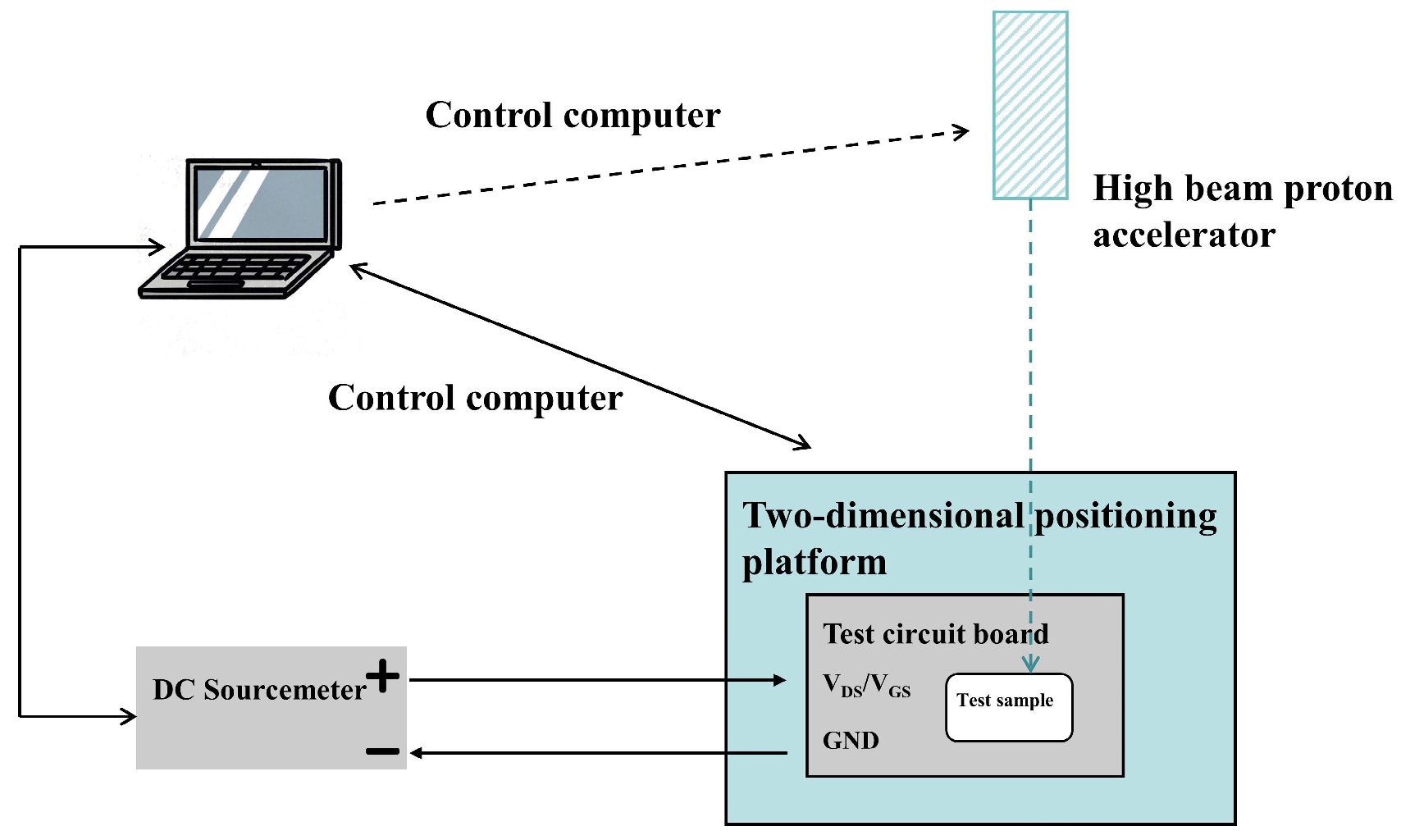

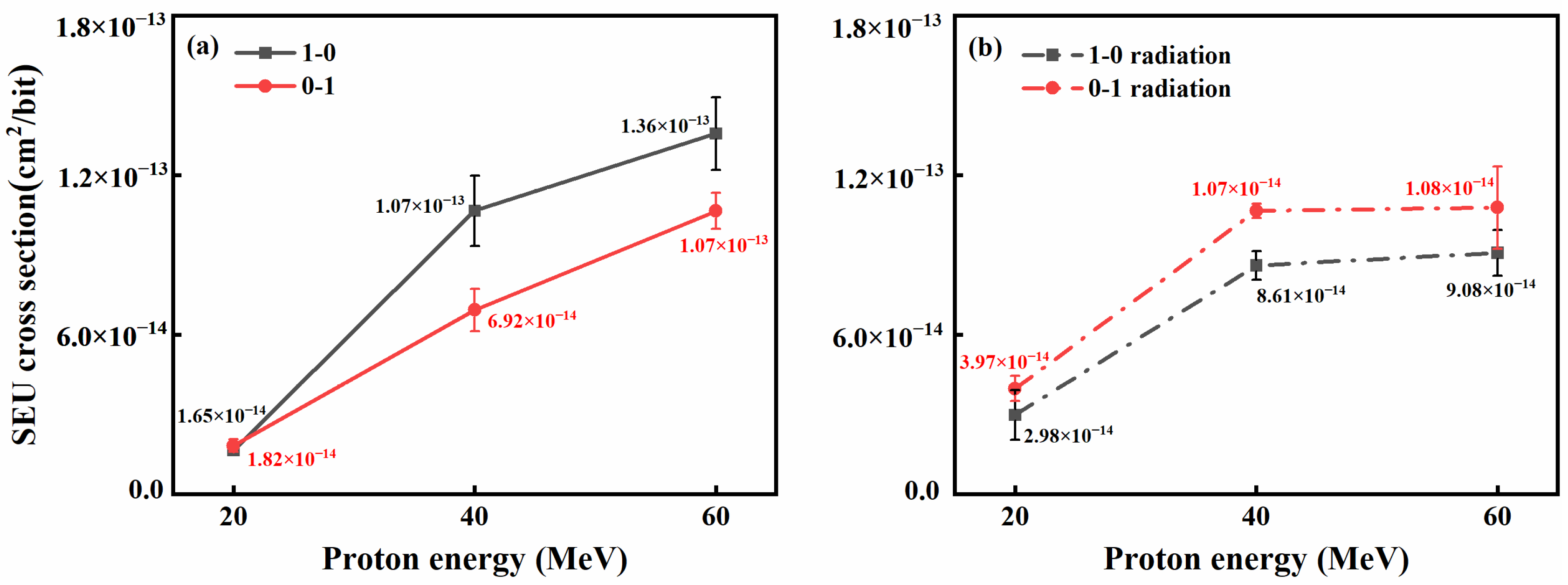

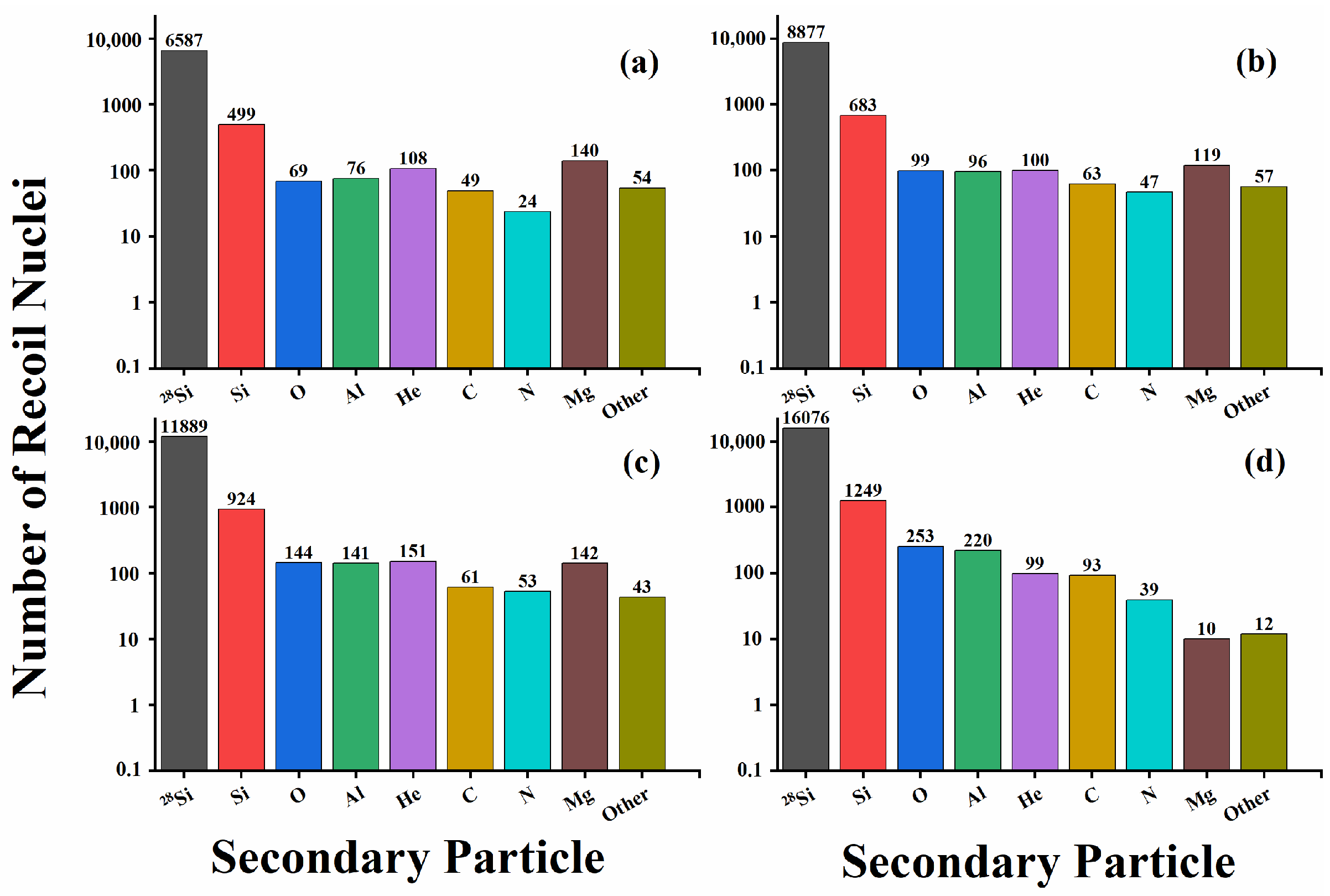
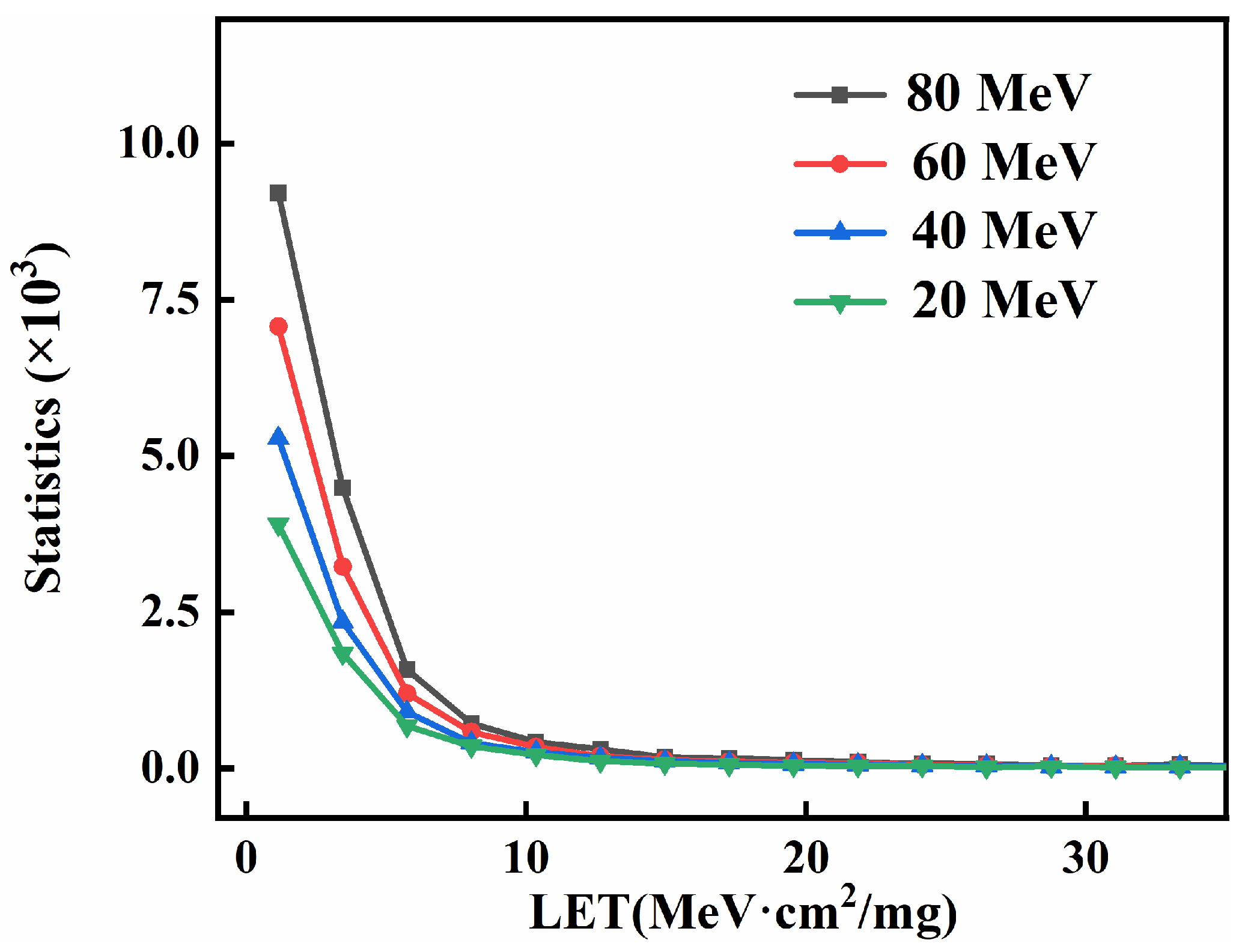
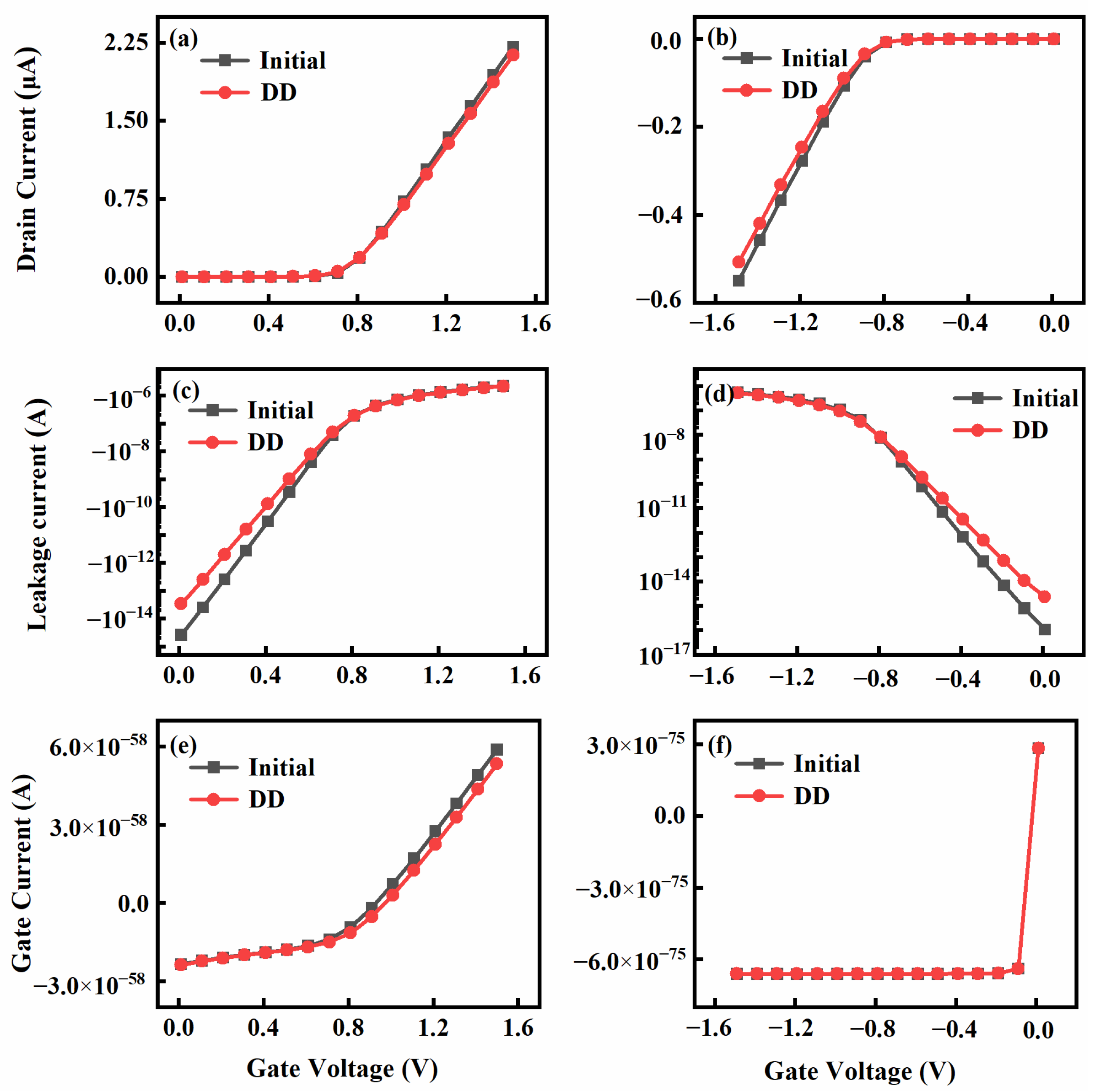
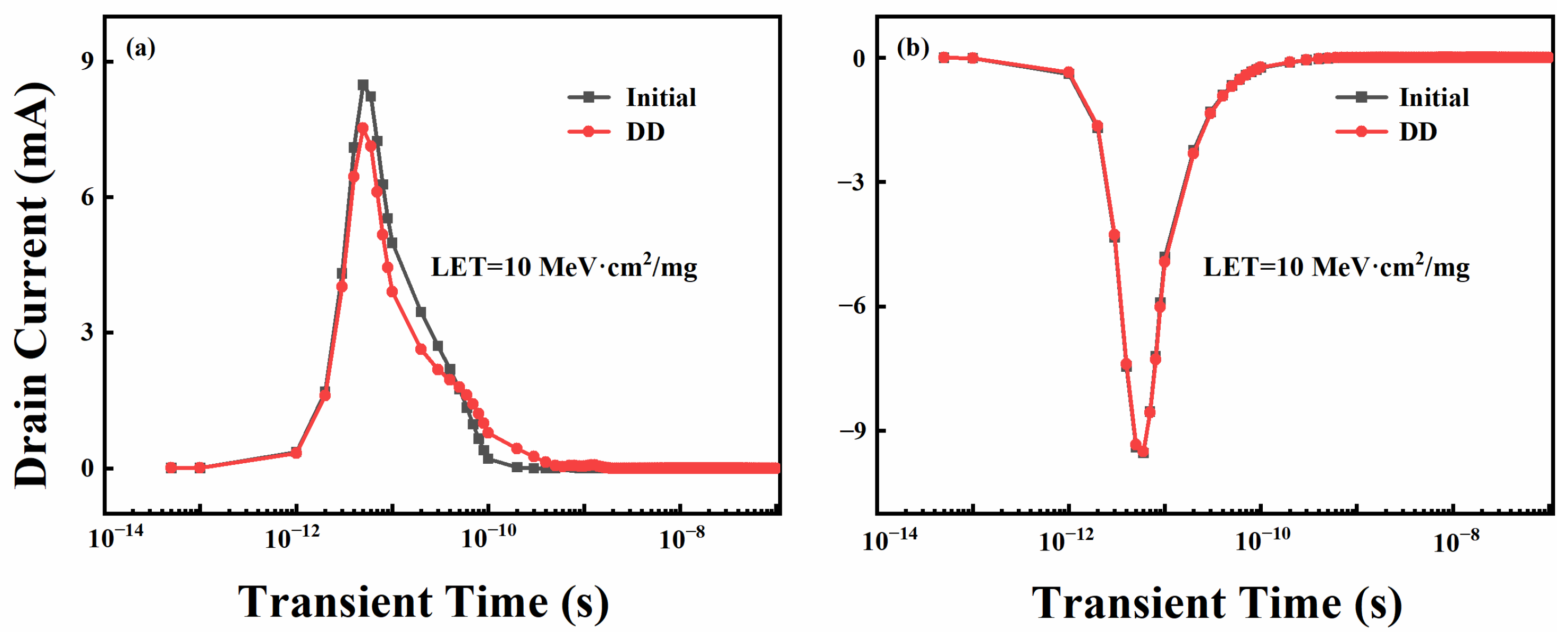
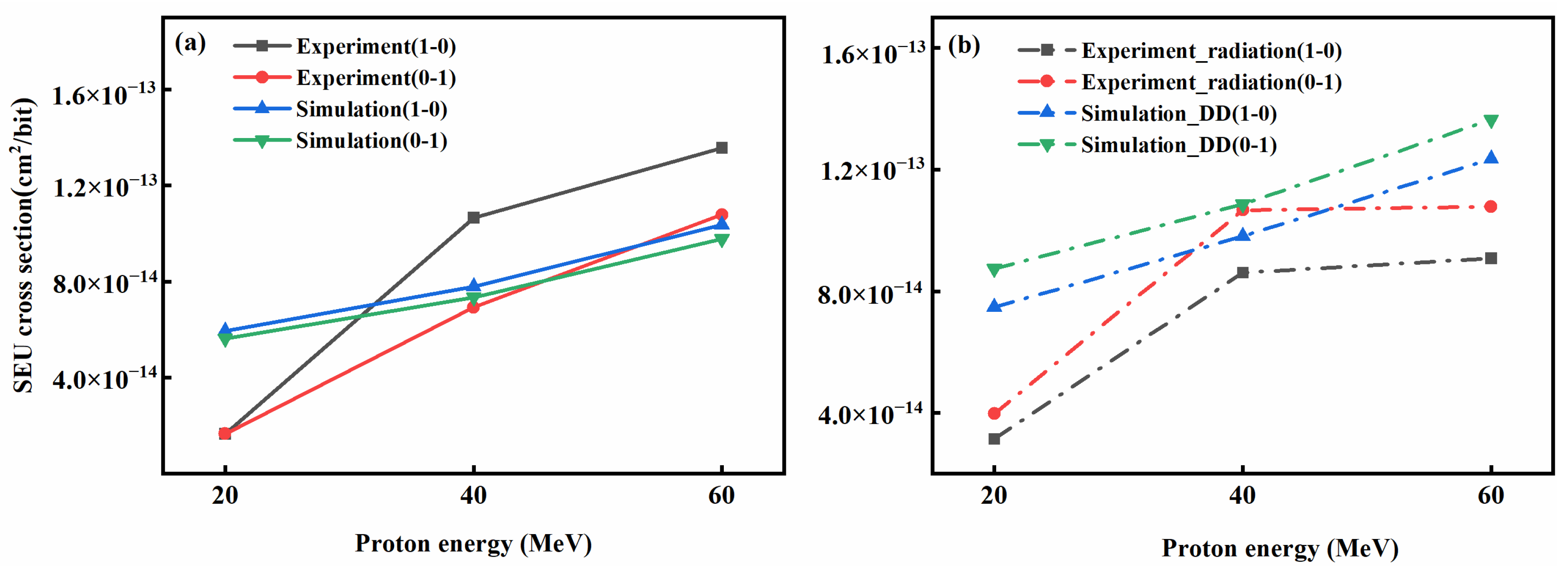


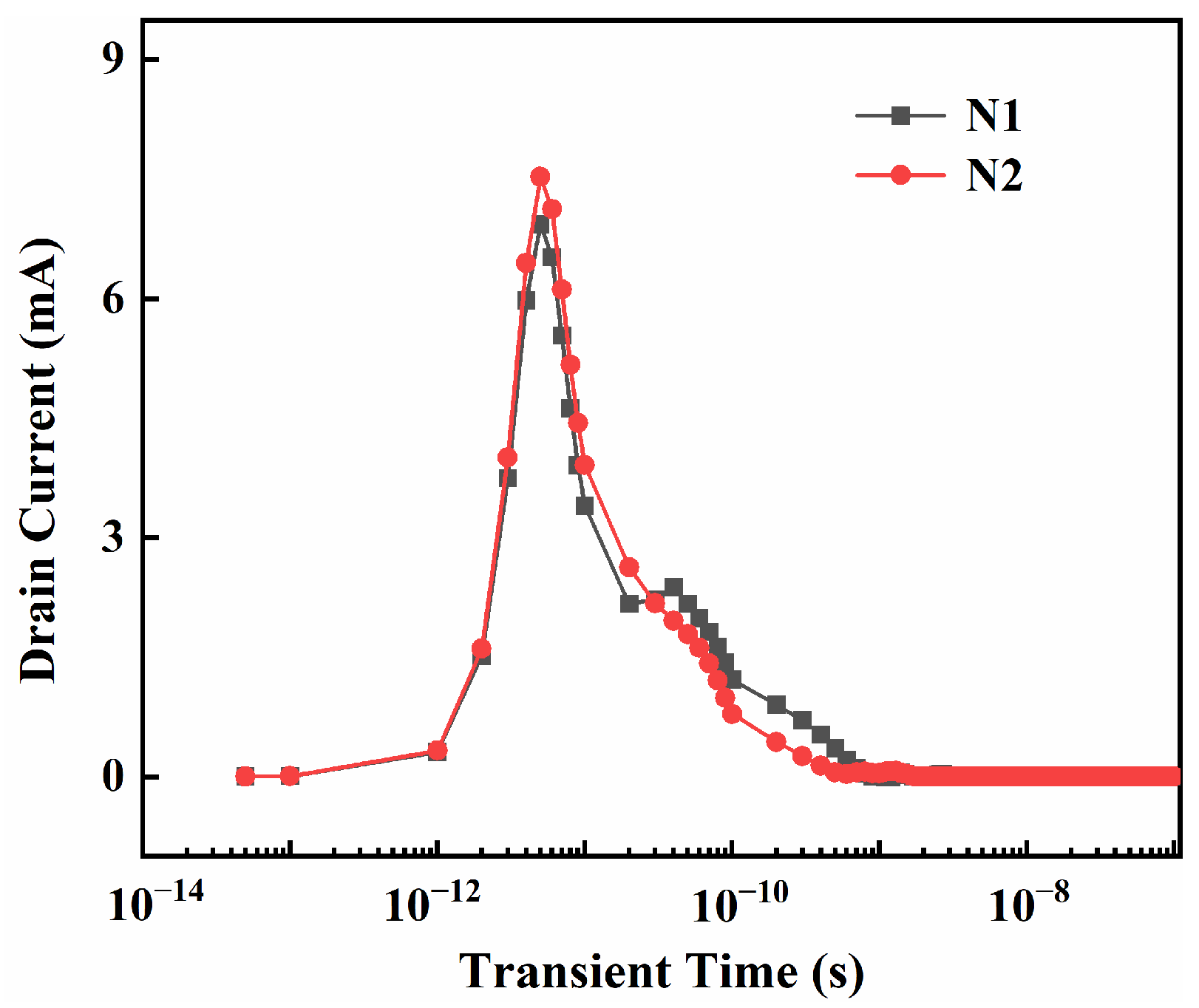
| Device | SRAM #1 | SRAM #2 | |
|---|---|---|---|
| Step | |||
| Step #1 | Energy (MeV)/Fluence (p/cm2) | 80/1 × 1014 | |
| Step #2 | Energy (MeV)/Fluence (p/cm2) | 20/9.45 × 109 | 20/9.45 × 109 |
| 40/8.35 × 109 | 40/8.35 × 109 | ||
| 60/1.29 × 1010 | 60/1.29 × 1010 |
| Item | Upsetting Counts | |||
|---|---|---|---|---|
| 20 MeV | 40 MeV | 60 MeV | ||
| SRAM #1 | 1-0 | 19 | 46 | 75 |
| 0-1 | 24 | 57 | 89 | |
| SRAM #2 | 1-0 | 10 | 57 | 112 |
| 0-1 | 9 | 37 | 89 | |
| Parameter | Value |
|---|---|
| Gate length/nm | 500 |
| Channel doping concentration/cm−3 | 2 × 1018 |
| Source/drain doping concentration/cm−3 | 2 × 1020 |
| Source/drain junction depth/nm | 180 |
| Gate oxide thickness/nm | 10 |
| Body region doping concentration/cm−3 | 1 × 1017 |
Disclaimer/Publisher’s Note: The statements, opinions and data contained in all publications are solely those of the individual author(s) and contributor(s) and not of MDPI and/or the editor(s). MDPI and/or the editor(s) disclaim responsibility for any injury to people or property resulting from any ideas, methods, instructions or products referred to in the content. |
© 2023 by the authors. Licensee MDPI, Basel, Switzerland. This article is an open access article distributed under the terms and conditions of the Creative Commons Attribution (CC BY) license (https://creativecommons.org/licenses/by/4.0/).
Share and Cite
Liu, Y.; Cao, R.; Tian, J.; Cai, Y.; Mei, B.; Zhao, L.; Cui, S.; Lv, H.; Zeng, X.; Xue, Y. Study of Single-Event Effects Influenced by Displacement Damage Effects under Proton Irradiation in Static Random-Access Memory. Electronics 2023, 12, 5028. https://doi.org/10.3390/electronics12245028
Liu Y, Cao R, Tian J, Cai Y, Mei B, Zhao L, Cui S, Lv H, Zeng X, Xue Y. Study of Single-Event Effects Influenced by Displacement Damage Effects under Proton Irradiation in Static Random-Access Memory. Electronics. 2023; 12(24):5028. https://doi.org/10.3390/electronics12245028
Chicago/Turabian StyleLiu, Yan, Rongxing Cao, Jiayu Tian, Yulong Cai, Bo Mei, Lin Zhao, Shuai Cui, He Lv, Xianghua Zeng, and Yuxiong Xue. 2023. "Study of Single-Event Effects Influenced by Displacement Damage Effects under Proton Irradiation in Static Random-Access Memory" Electronics 12, no. 24: 5028. https://doi.org/10.3390/electronics12245028
APA StyleLiu, Y., Cao, R., Tian, J., Cai, Y., Mei, B., Zhao, L., Cui, S., Lv, H., Zeng, X., & Xue, Y. (2023). Study of Single-Event Effects Influenced by Displacement Damage Effects under Proton Irradiation in Static Random-Access Memory. Electronics, 12(24), 5028. https://doi.org/10.3390/electronics12245028





